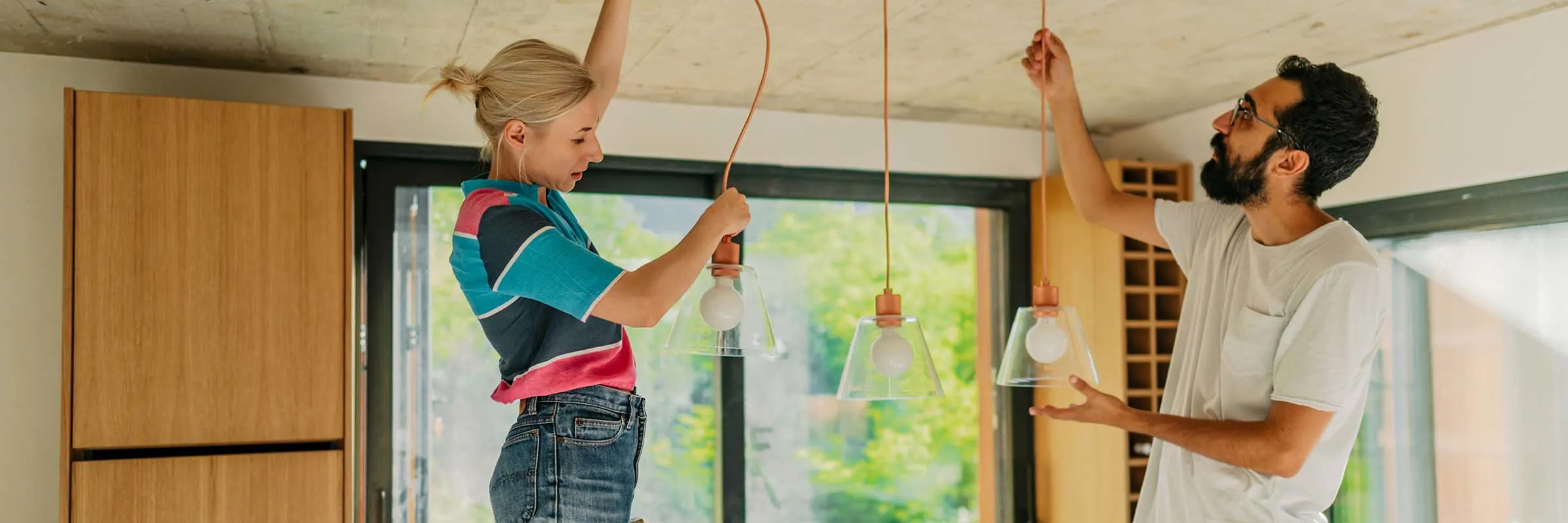What we'll cover
Different ways to redecorate on a budget
Decor ideas that do not require you to be crafty
How you can save money on larger DIY projects
To really make a house a home, it’s essential that it’s decorated to showcase your unique personality. Whether your style is chic, boho or minimalist, the right furniture and decor can transform a room into space that inspires and comforts you. Think you need to spend a fortune to make your home truly shine? Think again. Get thrifty (literally) and you can create your dream home on a totally doable budget.
What is DIY decor?
The key to DIY is maximizing what you already have at your fingertips — use a combo of found items and cheap supplies from thrift, craft and dollar stores to give your home personality and polish without breaking the bank. Here are seven home design ideas and strategies to give your living quarters a makeover on the cheap.
Build around used items
Before going out and splurging on a house full of brand-new furniture, spend a few weeks shopping around at thrift stores and online sources like Facebook Marketplace, Kaiyo or Letgo for used pieces. You can find some seriously amazing hidden gems.
And remember, you don’t have to go all or nothing. Say you scored a great second-hand dining table. You might decide to spend the money you saved on a new set of matching chairs. Similar to the concept of mixing high- and low-end fashion items, you can use a blend of brand-new and new-to-you furniture to create a polished look at a fraction of the price.
Repurpose and upcycle
One of the best (and most economic) thrifting strategies is shopping in your own home. Take another look at unused items with a creative lens to find new and interesting ways to repurpose them. Say you’re in the market for a new side table or nightstand, peruse your dusty bookshelf first. A stack of old encyclopedias or other sturdy hardcovers can make a cute table befitting any bookworm’s abode. And if you’re not ready to retire your reads just yet, check out your local thrift store for old tomes that fit the bill. With books large and sturdy enough, you won’t need anything else (although you may want some glue for stability). Add a decorative tray, a wooden board or a piece of glass for the base and top and you’re done.
Shopping in your home is also a great way to get inspiration for a gallery wall, which can add visual interest and personality to any area. The cool thing about this design feature is it can be as eclectic as you want. Grab some 3D objects like jewelry, pottery or sconces and mix them with photographs and art. You could also scope out your local thrift stores, garage sales and flea markets for interesting finds. Pick a color palette, and don’t be afraid to play with different themes and textures. (Seashells can immediately give beachy vibes while vintage album covers can give your space a musical motif.)
Refinish surfaces on the cheap
Refinishing furniture, walls and surfaces is a quick way to give your home a simple refresh. For instance, simple and inexpensive cosmetic upgrades can be a gamechanger for a fireplace that can really make it the cozy centerpiece your living room deserves. Paint the facade to give old brick a new look. Classic white or a touch of bold color will bring life into the room for the cost of a can of paint. (And don’t forget to look for paint at your local ReStore or online marketplace freebies). Take it a step further (with a relatively low budget) and upgrade your mantle with maple or pine boards, stained to match of course.
Other surface alternatives like faux concrete (who doesn’t love an eye-catching accent wall) or epoxy-covered countertops can revive outdated finishes and give you an upscale design without busting your budget.
Find flooring alternatives
Have you ever ripped up old carpeting only to find linoleum that’s even worse? Look outside the box for some cool DIY flooring options. Carpet tiles, wine corks, pennies, bottle caps and even peach pits can all be used to create inexpensive and unexpected flooring that makes for a truly unique and standout style. And if new floors seem a little overwhelming, a few layered (pre-owned) Persian rugs can do wonders to transform your space.
Channel your inner discount weekend warrior
For larger DIY projects, the cost of equipment and materials (brushes, glue guns, electrical kits, power tools) can add up quickly. Find ways to buy or rent materials and tools at a cheaper price. Resources like Habitat for Humanity and Facebook Marketplace can be treasure-troves for everything from pavers to paint to sanders and saws at steeply discounted prices. You can also join local, community-driven groups like NextDoor or Buy Nothing where trading, borrowing and giveaways are the name of the game (just don’t forget to pay it forward).
DIY design accessories
Any fashionista will tell you no outfit is complete without the right accessories. The same goes for your home’s decor. Once you have a great foundation with furniture, finishes and flooring, turn your attention to the smaller details that will tie it all together. This is where your DIY skills can really shine. Rather than dropping a lot of cash on expensive trinkets, use simple DIY hacks for your finishing touches.
For example, cane webbing is a woven, throwback material that’s perfect for cultivating a cottagecore aesthetic. If that’s your style, you can pick up this low-cost, retro and super-versatile material at your local craft store and use it to make everything from headboards and chairs to smaller items like coasters, votive candle holders or trendy napkin rings. Change up the color with spray paint and create a cane webbing design for every occasion. (Pro tip: Soak the webbing in warm water for 15 to 20 minutes so it’s flexible enough to manipulate.)
Want more DIY decor? Transform simple glass vases from the dollar store into something more sophisticated by painting them in an ombre style with high-gloss acrylic paint. Mix vases of varying shapes and sizes to create a visually interesting set. Time to capitalize on those crafting skills for homemade decor that provides the perfect personal touch.
DIY your way to your dream home decor scheme
When it comes to beautifying your home, you don’t have to spend a lot of money to create magazine-worthy digs. With inexpensive supplies, creativity and a little elbow grease, you can make some fabulous DIY projects that look professional. Get inspired and make your house a place you’re proud to call home.



